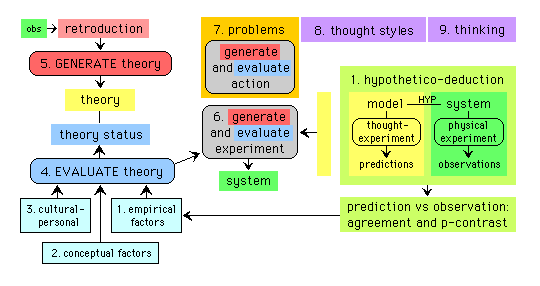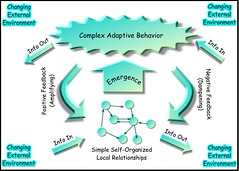Tuesday, May 31, 2005
Avatar Heaven
Psychologists and salesmen call it the "chameleon effect": People are perceived as more honest and likeable if they subtly mimic the body language of the person they're speaking with. Now scientists have demonstrated that computers can exploit the same phenomenon, but with greater success and on a larger scale.Won't intelligent avatar video spam of the future be great? Read about it here.
Princeton Art of Science Gallery
Roadcasting?
researchers at Carnegie Mellon University are developing an ad hoc networking system for cars that would allow any driver to broadcast music to any other vehicle within a 30-mile radius. . . vehicles with built-in 802.11p could serve as nodes in mesh networks and send each other safety notifications in case of accidents, or potential accidents. Acting as nodes in a mesh, each car would extend the network's signal a mile at a time.
Talk about mobile computing!
Monday, May 30, 2005
Just how good are those software requirements anyway?
Componetize it
Friday, May 27, 2005
Thinking about Thinking, Part 1 of 4
One idea is to use a thinking framework or tool. The hallmark of modern western thinking derives from Aristotle's deductive logic and Bacon's inductive logic combined into Galileo's scientific method. Using this framework should not be overlooked.
The simplest and maybe most widely used thinking tool is the journalist framework: who, what, when, where, why, and how.
Zachman put this journalist framework in the columns of a matrix and added reference perspectives in the rows of the matrix to create a framework for use in thinking through enterprise architecture. Modifying the reference perspectives, or the artifacts in the cells to the problem at hand would yield a very robust thinking framework.
Another good thinking framework is De Bono's Six Thinking Hats. Mindtools.com summarizes these as follows:
- White Hat:
With this thinking hat you focus on the data available. Look at the information you have, and see what you can learn from it. Look for gaps in your knowledge, and either try to fill them or take account of them. This is where you analyze past trends, and try to extrapolate from historical data.
- Red Hat:
'Wearing' the red hat, you look at problems using intuition, gut reaction, and emotion. Also try to think how other people will react emotionally. Try to understand the responses of people who do not fully know your reasoning.
- Black Hat:
Using black hat thinking, look at all the bad points of the decision. Look at it cautiously and defensively. Try to see why it might not work. This is important because it highlights the weak points in a plan. It allows you to eliminate them, alter them, or prepare contingency plans to counter them.
Yellow Hat:
The yellow hat helps you to think positively. It is the optimistic viewpoint that helps you to see all the benefits of the decision and the value in it. Yellow Hat thinking helps you to keep going when everything looks gloomy and difficult.
- Green Hat:
The Green Hat stands for creativity. This is where you can develop creative solutions to a problem. It is a freewheeling way of thinking, in which there is little criticism of ideas. A whole range of creativity tools can help you here.
- Blue Hat:
The Blue Hat stands for process control. This is the hat worn by people chairing meetings. When running into difficulties because ideas are running dry, they may direct activity into Green Hat thinking. When contingency plans are needed, they will ask for Black Hat thinking, etc.
[continued in part 2 . . .]
Thinking about Thinking, Part 2 of 4
Complexity theory suggests that an emergent process approach would be more fruitful than applying the formal frameworks cited in Part 1. Please bear with me as I develop this notion.
Edison said:
Genius is one per cent inspiration, ninety-nine per cent perspiration.If I twist that just a bit, we could say that
It takes 99 common ideas to generate one brilliant one.So, in simple terms, we start with a two-step process:
- generate lots of ideas
- winnow down to the brilliant ones.
Newton said:
If I have been able to see further, it was only because I stood on the shoulders of giants.I assume he was standing on the one percent brilliant ideas, not the 99 common ideas. In essense he was saying, when I contemplate the brilliant ideas that others have had, I get brilliant ideas I would have not otherwise had.
Let's add three more steps to the process:
- generate lots of ideas
- winnow down to the brilliant ones
- share the brilliant ones
- be inspired by the shared brilliant ideas
- go to steps 1 or 3.
An old French proverb says:
Le malheur des uns fait le bonheur des autres.Which means "the troubles of some make the joy of others" or as we say in English, "one man's trash is another man's treasure."
The question is, how do we know before hand which of all those common ideas is the brilliant one? We can't. What is a common idea to one person is a brilliant idea to another. It is almost circular -- what make's an idea brilliant is the brilliance it inspires in others. The important task is to preserve the intellectual pedigree(s) of brilliant ideas. This means preserving all the ideas, because we never know which we will want to link to (be brilliant) down the road.
We need to modify the process a little:
- generate lots of ideas
- preserve the ideas
- share the ideas
- be inspired by the shared ideas to be brilliant
- establish the links between your brilliant idea and its predecessors
- go to steps 1 or 3.
[continued in part 3 . . .]
Thinking about Thinking, Part 3 of 4
Steve Fuller observes:
Major scientific breakthroughs tend to come out of left field, often as a result of people trained in one field moving to another one, or of one field borrowing ideas and techniques from another.In the language of this essay, we would say that a person creates a new brilliant idea by linking together several disparate pre-existing brilliant ideas and adding enough intellectual glue that the whole new idea is greater than the sum of its parts.
In the language of complexity theory we would say that when feedback from the environment impinges upon a local stew of brilliant ideas, new brilliant ideas emerge as an adaptation to the changing environment. There is a sense of brilliant ideas bubbling up to the top of the heap. In the marketplace of ideas, the brilliant ideas become sought after hot commodities.
So how do we actually create, capture, save, search, and link to common and brilliant ideas?
I hope the reader has already come to the answer: BLOGS!
Blogs are designed for individuals to capture their brilliant ideas and their intellectual capital. It behooves all knowledge workers to document the creation of knowlege, or to narrate their work.
The blogosphere is full of 99 percent common ideas hiding one percent brilliant ideas. But blogs allow us to capture and save our ideas. Blogs can be indexed and searched. Blogs allow us to link to other ideas.
This last point is particularly important. It is this linking that allows a brilliant community to emerge. As important as a few brilliant ideas are, the real value comes when thousands of brilliant ideas create a brilliant ecology that is greater than the sum of its parts (cf. Aristotle, The Metaphysics).
[continued in part 4 . . .]
Thinking about Thinking, Part 4 of 4
In part one, I cited several thinking frameworks. These frameworks can be used by individuals or well organized, well managed, tight-knit groups operating in more or less real time. By contrast, the complexity theory approach to the generation of brilliant ideas is loosely coupled in time, across space, and throughout the organization. The complexity theory approach has a genetic algorithm feel to it. Ideas are combined and re-combined in many, many combinations and the brilliant ones survive.
To survive in the blogosphere means to have incoming links. The more incoming links to a particular post, the more value it has in shaping the community. Because authors want their blogs to be read (have their ideas considered to be brilliant), authors have an incentive to cite what they consider to be the most brilliant ideas by others, in hopes that their readers will also find the cited ideas brilliant. (See Dresner and Farrell paper.)
This is the mechanism that bubbles good ideas to the top. Frankly it doesn't matter what technique or framework is used to generate the idea. Its importance is in the value to other people, not in the method. Thus, in this model, it is more important to have lots of ideas propagating in the blogosphere. Applying the 99 to 1 rule tells us that we get more brilliant ideas out of 10,000 common ideas than we do out of 100 common ideas.
The keys are to blog early and often; to link frequently and generously; to share and share some more. While the thinking tools identified in part 1 will generate wisdom for a few, the blogosphere takes advantage of the Widsom of Crowds. Frankly, as a country we prefer electing candidates by the general population rather than by a few back-room polititians. The same principle applies to the blogosphere. There is more brilliance in the crowd than in the workgroup or task force.
[I'm not done, but I will stop here.]
Thursday, May 26, 2005
Internet Appliance

Inny or Outty
IT Consulting
Wednesday, May 25, 2005
Narrating Your Work . . .
The Big Time?
According to Blogshares, this blog is (today) worth $73.33. Where is venture capital when you need it?
Getting a Facial
Random Thought
- Howard Gardner's Changing Minds,
- Rebecca MacKinnon's The World Wide Conversation,
- Rob Cross, et. al.'s The Hidden Power of Social Networks,
- Christopher Locke, et. al.'s The Cluetrain Manifesto.
and maybe on
- Hugh Hewitt's Blog
- James Surowieki's Wisdom of Crowds,
- Malcolm Gladwell's The Tipping Point
Great Music Links
Javapedia!
Hold hands and sing S.O.A.
Tuesday, May 24, 2005
Don't Try This at Home
MS Virtual Earth vs Google Earth
Cyber Extortion Attack

Image source: us.news3.yimg.com
Friday, May 20, 2005
Crying While Eating
Google as Portal
Thursday, May 19, 2005
All Podcast Radio
Bad RFID
Not only is this bad, it is dumb.
Wednesday, May 18, 2005
Dead Podcasts
New External Links
Tuesday, May 17, 2005
Readers as Partners in Conversations
In an upcoming book titled We the Media, Dan Gillmor of the San Jose Mercury News. one of the first professional journalists to start a weblog . points out that new interactive forms of media have blurred the distinction between producers of news and their audience. In fact, some view the term "audience" to be obsolete in the new world of interactive participatory media. In the similarly-titled "We Media," a treatise on participatory journalism, Shayne Bowman and Chris Willis suggest that the "audience" should be re-named "participants" After several months of blogging, I prefer to think of them neither as an "audience" nor "participants," but as an "information community."
Redefining one's readers as converstion partners is a powerfully paradigm-shifting concept.
Monday, May 16, 2005
Great iPod Case
IBM Blue picks Firefox Orange
CNN gets a White Hat
Kumbaya
Friday, May 13, 2005
Firefox Fixes
Tuesday, May 10, 2005
Wikispecies!
Interesting . . .
Tiger Terror
BioTech Food in Your Bowl
Baby Babble Machine Translation
Monday, May 09, 2005
Emergence
My thinking about complex adaptive systems has been greatly influenced by the book entitled, Emergence, by Steven Johnson. Here is a an interview he gave to David Sims and Rael Dornfest at O'Reilly.
Knowldege Trees Falling Down?
Whoopsie
TechNewsWorld reports that Google was down for 15 minutes. The fact that a 15 minute outage is a news story indicates how much progress we have made on the internet. If only our internal network enterprise applications were so reliable.
Saturday, May 07, 2005
My First Wikipedia Graphics
Casey Jones, Watch Your Speed!
Thursday, May 05, 2005
Google beats Microsoft in Software
AMD beats Intel in Dual Core
Wednesday, May 04, 2005
flickr Fan
I have finally signed up for flickr. Here is my first upload--a graphic which depicts simple local relationships emerging into complex adaptive behavior. The other cool thing is that flickr allows me to put any keywords I want as metadata. Flickr publishes its most popular keywords. The flickr ontology was thus created as an emergent behavior -- just like depicted in my graphic.








